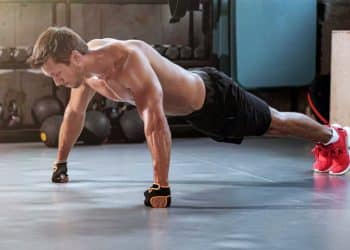Stability training has become one of the hottest fitness trends of the past few years. As a result, it’s common to see people doing gym exercises on an unstable surface to improve their balance and correct strength imbalances.
One of the most popular pieces of instability equipment is the Bosu ball. This strange-looking device is paired with various traditional gym exercises, including the squat.
While squatting on a Bosu ball may look cool and provide plenty of Instagram-worthy opportunities, is this a safe and practical thing to do in the gym?
As a veteran personal trainer and former gym owner, I’ve witnessed the evolution of the stability training trend right from its inception. I’ve explored the benefits and drawbacks of resistance training on an unstable surface with dozens of clients, including high-level athletes.
I’ve also delved into the related research and had first-hand experience with the potential drawbacks of combining instability with resistance training.
In this article, I’ll draw on those insights to help you decide if Bosu ball squats should be part of your training routine.
Level Up Your Fitness: Join our 💪 strong community in Fitness Volt Newsletter. Get daily inspiration, expert-backed workouts, nutrition tips, the latest in strength sports, and the support you need to reach your goals. Subscribe for free!
How To Do Bosu Ball Squat
The Bosu ball squat is a squat variation that involves performing the squat on the Bosu ball with either the curved or the flat side up. This creates instability, making you work to retain your balance while squatting.
I recommend starting with the curved side of the ball facing up. It is less complicated to balance with the flat surface on the floor.
The Bosu ball squat can be done as a bodyweight exercise or with added resistance using kettlebells, dumbbells, resistance bands, or barbells. There are several variations of the Bosu ball squat, each requiring a different level of balance.
Here are three ways to do the Bosu Ball Squat with increasing levels of resistance:
Bosu Ball Air Squat
- Stand on the Bosu ball with your feet shoulder-width apart and your toes pointing slightly outward. Extend your arms out in front of you. This will act as a counterbalance during the movement. Pull your shoulder blades back, maintaining a neutral spine position.
- Hinge at the hips and slowly lower to a parallel squat position.
- Focus on keeping your body upright so that you don’t lean forward. Think about sitting back into the ball as you go down.
- Push through your quadriceps to come back to an upright position. Simultaneously, drive your arms down on your sides.
Bosu Ball Resistance Band Squat
Some stability balls come with hooks on the base to attach a resistance band. Hold the bands at shoulder level to add resistance as you push out of the bottom squat position.
Alternatively, you can loop a flat resistance band under your feet and hold it at shoulder level with palms facing forward while squatting. Do not use a tube band, as it will create an even more unstable surface.
Bosu Ball Kettlebell Squat
To perform a kettlebell squat on the Bosu ball, you should stand on the ball with a shoulder-width stance and feet slightly pointed out. Hold a single kettlebell by the handles in front of your chest and maintain an upright body position throughout the movement. Otherwise, perform the exercise as outlined for the air squat.
What is a Bosu Ball?
A Bosu ball is half of a standard exercise ball. One side is flat, while the other is curved and inflated. The ball is designed to enhance a person’s balance.
The unstable surface of the Bosu ball forces you to engage more muscles during an exercise than performing the same movement on a stable platform. You can do both cardio and resistance exercises with the Bosu ball.
You can perform exercises on the flat and curved surfaces. Physiotherapists have been using stability balls for decades to help people improve their balance, strength, and proprioception.
Notably, Bosu is a brand name and not a generic term. The word is an acronym for ‘Both Sides Utilized.’ The category for this product is stability ball.
Rise of Balance Training
Balance training became part of the gym scene in the late 1990s. Before that, it was not considered part of the overall fitness equation. Today, many people feel that working on their balance is an essential fitness component.
The rise of balance training among the general population has coincided with proprioception training among high-level athletes and physiotherapists. Proprioception refers to your ability to know what a body part is doing without looking at it.
Sports coaches and physios used balance training to address specific and unique needs of players and patients. Even though the needs of general fitness goers are very different from these two groups, balance training — as done by the pros — became the big new thing in the gym scene in the early 2000s.
Before you knew it, a whole new category of fitness products — stability training equipment — was created.
The Case For Bosu Ball Squats
There are several benefits of using a Bosu ball when squatting. Let’s consider the three most commonly cited benefits of Bosu squats:
Improved Balance
The primary benefit of doing any exercise on a Bosu ball is that it increases a person’s balance.
A 2007 metastudy published in the International Journal of Sports Physical Therapy considered the effectiveness of instability training in rehab. Eleven previous studies were analyzed.
The balance and proprioception measures averaged an improvement of 105 percent. The researchers concluded, “Physical therapists should consider IRT [instability resistance training] as a progressive component in the rehabilitation training program.” [1]
Notably, this study, and others like it, are specific to people recovering from injury or who have pre-existing balance problems. There is no doubt that stability training will benefit these populations, especially the elderly.
Level Up Your Fitness: Join our 💪 strong community in Fitness Volt Newsletter. Get daily inspiration, expert-backed workouts, nutrition tips, the latest in strength sports, and the support you need to reach your goals. Subscribe for free!
It is unclear whether exercising on an unstable surface will help the general population improve their balance on a stable surface.
Core Activation
You may have trainers say that Bosu ball squats activate your stabilizers. The truth is that your body does not have any specific ‘stability muscles.’ Generally, what we are talking about here is the core.
The core muscles include:
- Rectus abdominis
- Transverse abdominis
- Internal and external obliques
- Erector spinae
When doing a Bosu ball squat, your transverse abdominis and erector spinae muscles must stabilize the pelvis and spine. During the descent and ascent, your obliques are recruited to prevent unwanted movement and stop you from toppling to either side.
Injury Rehab
When recovering from a leg injury, it can be quite painful to do squats on a solid surface like the floor. You can reduce the impact on your legs by performing squats on a soft surface, like the Bosu ball.
However, a person with a leg injury must be very confident in the balance department before squatting on a Bosu ball. Doing so obviously puts them at risk of re-injury. That said, people recovering from an injury or those dealing with other health issues must get their doctor’s clearance before starting an exercise program.
The Case Against Bosu Ball Squats
In case you haven’t got the vibe yet, let me state that I am not a fan of Bosu ball squats. That is not an opinion I’ve come to lightly.
I have used Bosu balls with a lot of people over the years. My clients include professional athletes, seniors, and young people focused on general fitness. My view is based on a combination of science and real-world knowledge.
In this section, I’ll explain my reasons for not advocating Bosu ball squats.
It’s Not Really Balance Training
An exercise done on an unstable surface is not an example of balance training. Balance, or spatial orientation, is something we are born with. As we age, we may start to lose our balance, leading to disequilibrium.
If you have problems with your balance, you need to see a physiotherapist rather than a gym instructor. For people who have not been diagnosed with a balance problem, doing balance training would be like all of us wearing prescription glasses even though we have optimal 20/20 vision.
What you are doing on a Bosu ball is an example of proprioception training. This is when you are developing a new skill. That skill is to be able to control your limbs without looking at them or thinking about them.
The goal of proprioception training is for the movement to become automatic — like Michael Jordan shooting a basketball with his eyes closed. The critical thing to remember with proprioception training is that it is specific to the action you are doing.
In other words, doing squats on an unstable surface will make you better at doing squats on an unstable surface; it will not make you better at doing squats on a solid surface.
If you play a sport requiring exceptional reactive speed and ability in the legs, Bosu ball squats may benefit you. Otherwise, it’s not going to have much value.
Compromising Target Muscle Efficiency
When you do a Bosu ball squat, you work your target muscles — the quads, glutes, and core. Unfortunately, it works each of these muscles less effectively than if you were to work them separately.
When you have to worry about your balance, you cannot help but compromise your ability to execute and produce force on the squat. If you don’t believe me, imagine what it would be like to perform a set of squats on a gym floor covered in oil. You’d have to use a much lighter resistance to prevent yourself from slipping.
It’s the same thing with a Bosu ball, just to a lesser extent. Yet, you are doing squats to activate maximum muscle stimulation in the lower body so that those muscles respond by becoming bigger and stronger. So, why would you do them in a way that will work against that goal?
It is Unsafe
You’ve probably seen YouTube clips of people doing barbell squats on a Bosu ball. It might look good online; personally, I think it looks ridiculous. It is a very dangerous thing to do. Lose your footing, and you are in for a potentially life-altering injury.
The Bosu ball variation of a squat can be risky, even without adding multiple weight plates. Even when done with no weight, you can easily fall off, twist your ankle, and be out of action for several weeks.
I’ve seen this happen on several occasions. The effect each time has been that the consistent progress that the person was making came to a screeching halt.
One lady hadn’t missed a workout for three months and was making significant progress on her weight loss goal. Then she fell off a Bosu ball and twisted her left ankle. She was off her feet for three weeks, and it took her another month to get back on track. During that seven weeks of downtime, she put back on all the weight she’d managed to lose prior to the injury!
Wrapping Up
The Bosu ball is an effective tool to help you develop proprioceptive skills. As we’ve seen, however, that skill is not needed by all of us. It will benefit certain athletes and people with compromised balance.
Most of us are not in those categories. Doing squats on a Bosu ball will not improve your balance. Instead, it will make the squat less effective, compromising your form and limiting your ability to engage the target muscles and produce force. It will also greatly increase your risk of injury.
References
- Behm D, Colado JC. The effectiveness of resistance training using unstable surfaces and devices for rehabilitation. Int J Sports Phys Ther. 2012 Apr;7(2):226-41. PMID: 22530196; PMCID: PMC3325639.
Interested in measuring your progress? Check out our strength standards for Squat.











